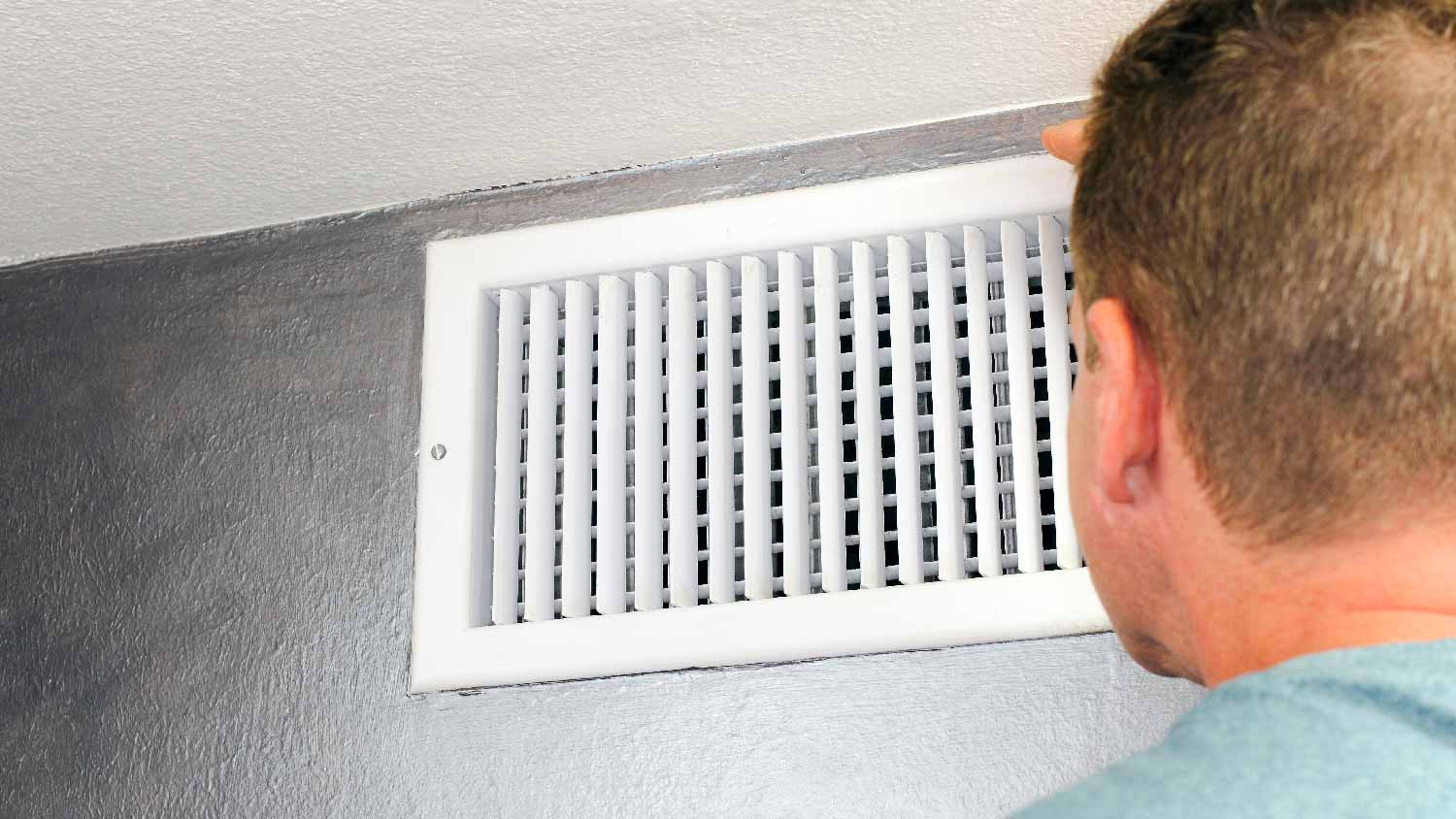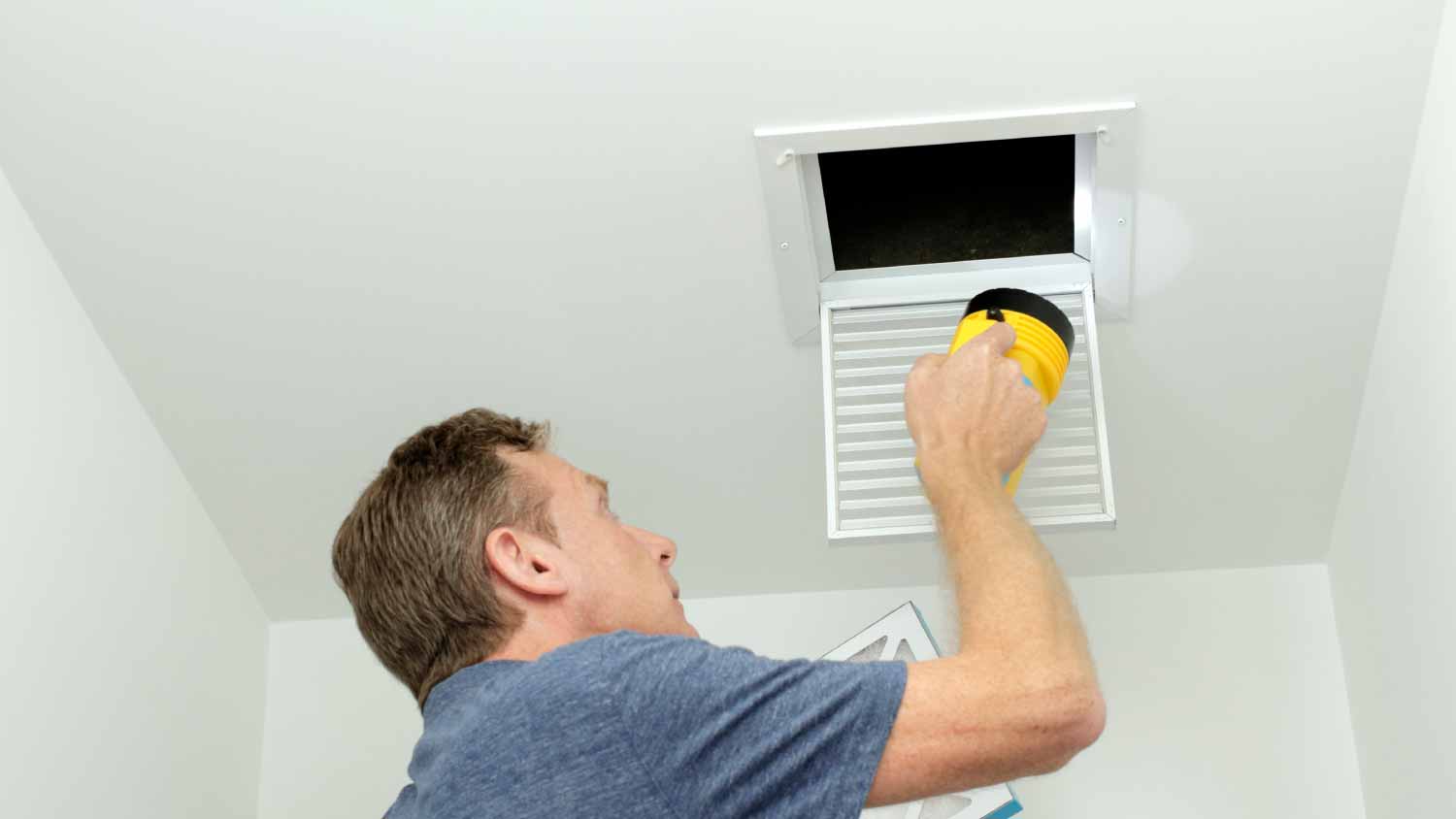
Whole-house air purifier costs depend on a variety of factors, including your home’s size and layout. The type of purifier you choose matters, too.
Dirty ducts do damage to your digs (and lungs)


All kinds of pollutants can accumulate in your ductwork.
Dirty filters can cause black particles to spew from vents.
Black particles can indicate more severe problems like mold or pests.
Having your ductwork cleaned can likely fix this issue.
Imagine cranking up the AC on a hot day, only to find black particles coming out of the air vents. These black specks can be anything from dirt to black mold to crumbling old insulation. The good news is that this problem with your vents is fixable. We'll show you common causes of black stuff coming out of air vents and what you can do about it.
Dust seems to proliferate constantly, even if you're very diligent about wiping down areas and regularly vacuuming. It practically takes daily professional cleaning to avoid dust build-up in your home, especially in areas you don't use often. Dirt can also get in from the outdoors. Dark dust quickly accumulates in ductwork gaps, such as the duct chases often placed in attics.
These substances build up until the filter is too clogged to take anymore, and it has to come out some way. That's why you see black specks coming from the air vents.
The fix for dust, dirt, and grime on your air filter is simple—just replace the filter. This is a quick, easy, and low-cost DIY solution that will keep those pesky black specks out of your home’s air.

Candlelit dinners just became less romantic. While the occasional seance won’t cause major HVAC problems, routinely burning firewood, candles, incense, and other combustible materials releases soot into the air. It then recirculates through the air ducts and, eventually, comes back out of the air vents.
Dirty air filters are a common and overlooked culprit of many HVAC problems. When the filter gets clogged with heavy amounts of dirt, dust, debris, and soot, it eventually stops catching these nasties and recirculates them back into the ductwork. This is terrible news if you have a dust allergy or just don’t want black stuff constantly spewing from the air vents.
Fortunately, this problem has an easy solution. Clean the filter if it’s still serviceable, or replace it if the dirt is caked on. If you like to burn candles and firewood, upgrading to a stronger new filter that can handle tough pollutants like soot is the way to go.
Black mold thrives in air ducts, especially if they become moist from summer condensation. This can turn your ductwork into a breeding ground for black mold, and seeing those black specks is a sign that they've conquered the ducts, and now the rest of your home is under siege.
Try rubbing it with a mixture of bleach and water. If the black spots wipe off easily, it isn't black mold. If the spots are incredibly resistant, or they do come off but leave a dark stain, you need to get a mold abatement professional over ASAP before it spreads.
Black mold is a very concerning problem that can dangerously spiral out of control and fast. Visible black mold can cause serious health problems. According to the National Institute of Environmental Health Sciences, black mold impacts can range from allergic reactions like nasal distress and itchy skin to asthma. If any household members experience these reactions after the black specks appear, mold is likely the cause.
Young children, the elderly, and immunocompromised people are at especially high risk of severe illness from black mold exposure. If this describes anyone in your household, it’s imperative that you contact a local mold abatement professional.

Everyone loves a clean, fluffy blanket, but frequently doing large loads of laundry can shake excessive dryer lint into the ductwork. It’s important to clean the lint trap after every dryer load, but it can’t completely prevent colossal amounts of lint from reaching the air ducts.
If you’re wondering how dryer lint got into your air ducts, dryer hoses can be knocked loose. Check whether the hose is still connected to the dryer and how close it is to entry points in the ductwork. Reconnect it, and that should stop the lint problems.
If you’re not familiar with the grim discovery that mice now share your home, nibble marks and droppings that resemble chocolate sprinkles are often the telltale signs. Pests in dryer vents might be the cause of the black stuff blowing out. Even if you’ve taken all precautions at the ground level, like caulking gaps in baseboards, rodents can easily squeeze themselves into small spaces. Mice and other critters can invade your home through dryer vents and other entry points in your ductwork.
Even if you don’t see telltale signs of mouse infestation at the ground level, do you hear scratching noises? If you do, you’ve got unwanted guests in the ducts. Call a local pest control professional since they have the tools to handle situations like this.
HVAC and plumbing professionals can also be a good line of defense against infestations.
If you’ve ever had one of those beloved T-shirts you couldn’t let go of, it becomes see-through with time and repeated rounds in the washing machine. The same thing happens with your insulation over time.
While you won’t be able to see it, bits of it will disintegrate just like those decades-old concert tour T-shirts do. This insulation falls into the ductwork and gets sprayed out of the air vents.
Insulation comes apart with age, and these shreds can fall into the ductwork and create fiberglass confetti. Exposure to fiberglass dust can cause skin, lung, and eye problems, so this needs to be rectified immediately. This could mean patching leaky ductwork or replacing insulation in ducts or walls that are shedding old insulation.
The Environmental Protection Agency recommends professional duct cleaning if there is visible mold growth, excessive dust, or pest infestations. If it’s been about five years since the ducts were last cleaned, that’s also a good time to call your local duct installer to arrange cleaning.
Air duct cleaning costs $150 to $800, though most people pay an average of $380 for the service. What you pay will depend on the number of vents you have and the linear feet of ductwork. Your home’s layout and duct accessibility are also price factors.
Kay Lynn and her team clean and maintain multiple hot tubs for me at vacation rentals that I manage and they do an awesome job! She is always quick to respond and makes sure the tubs are ready to go. As you can imagine in the vacation rental industry, clean hot tubs are huge for customer...
Kurtis from Bend Home Management Solutions was GREAT to work with! He was professional, punctual, responsive to questions, and did excellent quality work. I recommend him without reservation and hope to have the opportunity to work with him again in the future.
Good people I did not use them I used another pro but still good people
From average costs to expert advice, get all the answers you need to get your job done.

Whole-house air purifier costs depend on a variety of factors, including your home’s size and layout. The type of purifier you choose matters, too.

Curious about air duct cleaning costs? Get insights into pricing factors, benefits, and how to tell when it’s time for a good cleaning.

Air duct cleaning is a service for homes affected by mold, pests, or excess dust. Use this guide to find a good air duct cleaning company.

Don’t fall victim to air duct cleaning ripoffs and scams! Make sure you understand these 5 common scams to avoid throwing away money on your HVAC system.

Dirty air vent covers can reduce air quality throughout the home. Here are some easy and efficient ways to clean air vent covers in your house.

Air duct cleaning is a very common service, but is it necessary for your home? Here are the signs to watch for and when duct cleaning is beneficial.